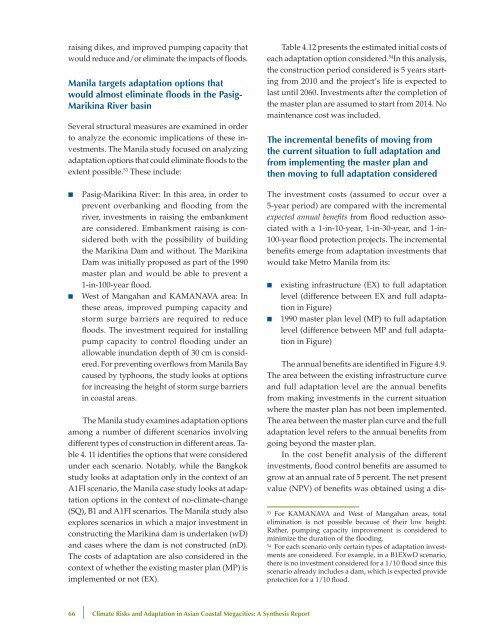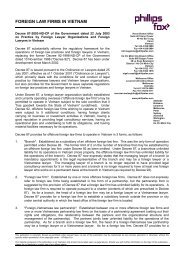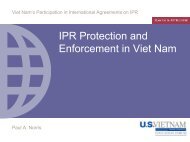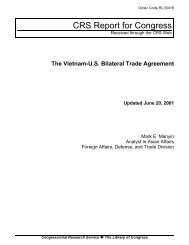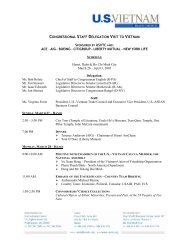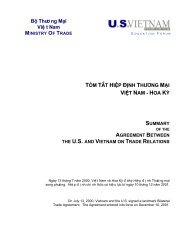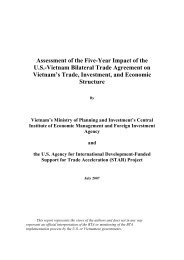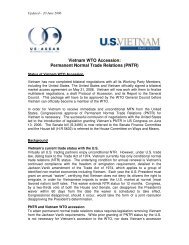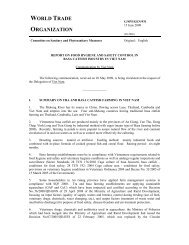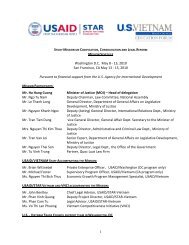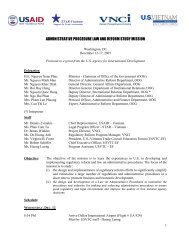Climate risks and adaptation in Asian coastal megacities: A synthesis
Climate risks and adaptation in Asian coastal megacities: A synthesis
Climate risks and adaptation in Asian coastal megacities: A synthesis
- No tags were found...
Create successful ePaper yourself
Turn your PDF publications into a flip-book with our unique Google optimized e-Paper software.
ais<strong>in</strong>g dikes, <strong>and</strong> improved pump<strong>in</strong>g capacity thatwould reduce <strong>and</strong>/or elim<strong>in</strong>ate the impacts of floods.Manila targets <strong>adaptation</strong> options thatwould almost elim<strong>in</strong>ate floods <strong>in</strong> the Pasig-Marik<strong>in</strong>a River bas<strong>in</strong>Several structural measures are exam<strong>in</strong>ed <strong>in</strong> orderto analyze the economic implications of these <strong>in</strong>vestments.The Manila study focused on analyz<strong>in</strong>g<strong>adaptation</strong> options that could elim<strong>in</strong>ate floods to theextent possible. 53 These <strong>in</strong>clude:■■■■Pasig-Marik<strong>in</strong>a River: In this area, <strong>in</strong> order toprevent overbank<strong>in</strong>g <strong>and</strong> flood<strong>in</strong>g from theriver, <strong>in</strong>vestments <strong>in</strong> rais<strong>in</strong>g the embankmentare considered. Embankment rais<strong>in</strong>g is consideredboth with the possibility of build<strong>in</strong>gthe Marik<strong>in</strong>a Dam <strong>and</strong> without. The Marik<strong>in</strong>aDam was <strong>in</strong>itially proposed as part of the 1990master plan <strong>and</strong> would be able to prevent a1-<strong>in</strong>-100-year flood.West of Mangahan <strong>and</strong> KAMANAVA area: Inthese areas, improved pump<strong>in</strong>g capacity <strong>and</strong>storm surge barriers are required to reducefloods. The <strong>in</strong>vestment required for <strong>in</strong>stall<strong>in</strong>gpump capacity to control flood<strong>in</strong>g under anallowable <strong>in</strong>undation depth of 30 cm is considered.For prevent<strong>in</strong>g overflows from Manila Baycaused by typhoons, the study looks at optionsfor <strong>in</strong>creas<strong>in</strong>g the height of storm surge barriers<strong>in</strong> <strong>coastal</strong> areas.The Manila study exam<strong>in</strong>es <strong>adaptation</strong> optionsamong a number of different scenarios <strong>in</strong>volv<strong>in</strong>gdifferent types of construction <strong>in</strong> different areas. Table4. 11 identifies the options that were consideredunder each scenario. Notably, while the Bangkokstudy looks at <strong>adaptation</strong> only <strong>in</strong> the context of anA1FI scenario, the Manila case study looks at <strong>adaptation</strong>options <strong>in</strong> the context of no-climate-change(SQ), B1 <strong>and</strong> A1FI scenarios. The Manila study alsoexplores scenarios <strong>in</strong> which a major <strong>in</strong>vestment <strong>in</strong>construct<strong>in</strong>g the Marik<strong>in</strong>a dam is undertaken (wD)<strong>and</strong> cases where the dam is not constructed (nD).The costs of <strong>adaptation</strong> are also considered <strong>in</strong> thecontext of whether the exist<strong>in</strong>g master plan (MP) isimplemented or not (EX).Table 4.12 presents the estimated <strong>in</strong>itial costs ofeach <strong>adaptation</strong> option considered. 54 In this analysis,the construction period considered is 5 years start<strong>in</strong>gfrom 2010 <strong>and</strong> the project’s life is expected tolast until 2060. Investments after the completion ofthe master plan are assumed to start from 2014. Noma<strong>in</strong>tenance cost was <strong>in</strong>cluded.The <strong>in</strong>cremental benefits of mov<strong>in</strong>g fromthe current situation to full <strong>adaptation</strong> <strong>and</strong>from implement<strong>in</strong>g the master plan <strong>and</strong>then mov<strong>in</strong>g to full <strong>adaptation</strong> consideredThe <strong>in</strong>vestment costs (assumed to occur over a5-year period) are compared with the <strong>in</strong>crementalexpected annual benefits from flood reduction associatedwith a 1-<strong>in</strong>-10-year, 1-<strong>in</strong>-30-year, <strong>and</strong> 1-<strong>in</strong>-100-year flood protection projects. The <strong>in</strong>crementalbenefits emerge from <strong>adaptation</strong> <strong>in</strong>vestments thatwould take Metro Manila from its:■■■■exist<strong>in</strong>g <strong>in</strong>frastructure (EX) to full <strong>adaptation</strong>level (difference between EX <strong>and</strong> full <strong>adaptation</strong><strong>in</strong> Figure)1990 master plan level (MP) to full <strong>adaptation</strong>level (difference between MP <strong>and</strong> full <strong>adaptation</strong><strong>in</strong> Figure)The annual benefits are identified <strong>in</strong> Figure 4.9.The area between the exist<strong>in</strong>g <strong>in</strong>frastructure curve<strong>and</strong> full <strong>adaptation</strong> level are the annual benefitsfrom mak<strong>in</strong>g <strong>in</strong>vestments <strong>in</strong> the current situationwhere the master plan has not been implemented.The area between the master plan curve <strong>and</strong> the full<strong>adaptation</strong> level refers to the annual benefits fromgo<strong>in</strong>g beyond the master plan.In the cost benefit analysis of the different<strong>in</strong>vestments, flood control benefits are assumed togrow at an annual rate of 5 percent. The net presentvalue (NPV) of benefits was obta<strong>in</strong>ed us<strong>in</strong>g a dis-53For KAMANAVA <strong>and</strong> West of Mangahan areas, totalelim<strong>in</strong>ation is not possible because of their low height.Rather, pump<strong>in</strong>g capacity improvement is considered tom<strong>in</strong>imize the duration of the flood<strong>in</strong>g.54For each scenario only certa<strong>in</strong> types of <strong>adaptation</strong> <strong>in</strong>vestmentsare considered. For example, <strong>in</strong> a B1EXwD scenario,there is no <strong>in</strong>vestment considered for a 1/10 flood s<strong>in</strong>ce thisscenario already <strong>in</strong>cludes a dam, which is expected provideprotection for a 1/10 flood.66 | <strong>Climate</strong> Risks <strong>and</strong> Adaptation <strong>in</strong> <strong>Asian</strong> Coastal Megacities: A Synthesis Report


